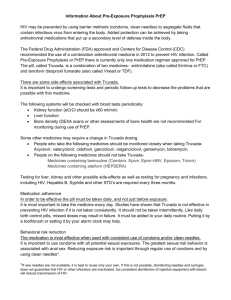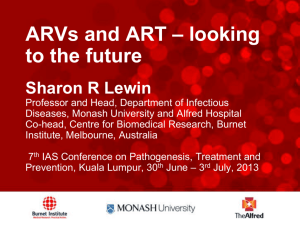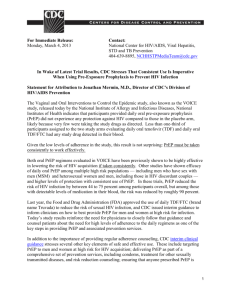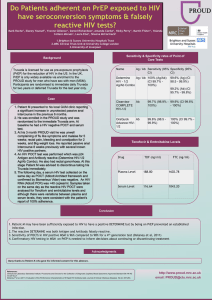ART as prevention: PEP & PrEP
advertisement
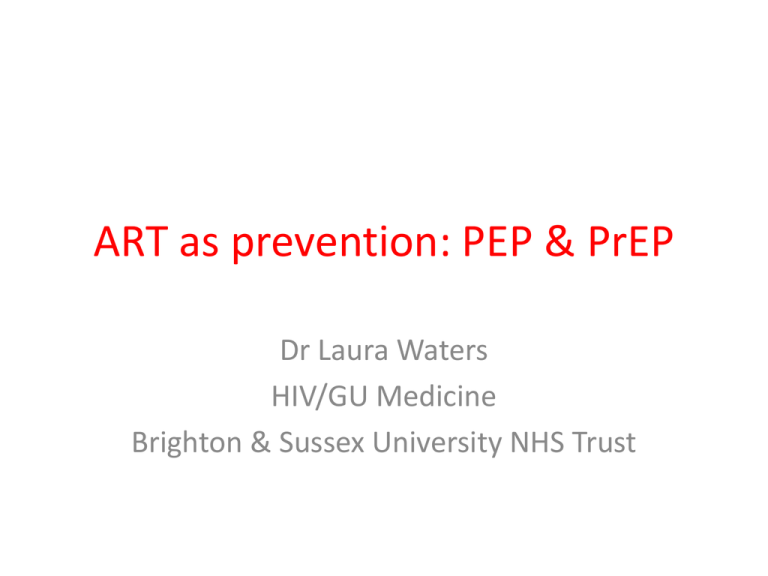
ART as prevention: PEP & PrEP Dr Laura Waters HIV/GU Medicine Brighton & Sussex University NHS Trust Introduction • HIV prevention overview • Using ART • In HIV negative • Pre-exposure prophylaxis (PrEP) • Post-exposure prophylaxis (PEP) • In HIV positive • Treatment as prevention Prevention is the Foundation For Treatment Sustainability GLOBALLY 6 new infections for every person started on therapy! Prevention Methods HIV Prevention Behavioural Structural Biomedical Determinants of risky sexual behaviour • Individual factors • Low self-esteem, lack of skills, lack of knowledge • External influences • Peer pressure/attitudes & prejudices of society • Service provision • Accessibility of sexual health services, resources (condoms) www.nice.org.uk/PHI003 Structural • • • • • • • • Testing programmes & earlier diagnosis Needle Exchanges Condom Provision STI control Targeted outreach services Targeted education Tackling Legal barriers Tackling Stigma Biomedical • Circumcision • 57% reduction in acquisition (RCT) • 43% less transmission to females (cohort) • Microbicides • Many failures • Only ART containing have shown good efficacy • ARV therapy • Treatment as Prevention • PEP • PrEP • Vaccines • The holy grail • Many failures • Moderate effect at best Biomedical • Circumcision • 57% reduction in acquisition (RCT) • 43% less transmission to females (cohort) • Microbicides • Many failures • Only ART containing have shown good efficacy • ARV therapy • Treatment as Prevention • PEP • PrEP • Vaccines • The holy grail • Many failures • Moderate effect at best Post-exposure prophylaxis (PEP) • Occupational • Needle stick injury (NSI) • Mucosal exposure • Non-occupational • Sexual exposure (PEPSE) • Sexual assault Significant exposure • Percutaneous injury, contact of mucous membrane or non-intact skin, with: • Blood, tissue or other bodily fluids • Bodily fluids: • Semen, vaginal secretions • Any blood stained fluid (CSF, synovial, amniotic, pleural, peritoneal, pericardial fluids) • Saliva (only in association with dentistry) • Unfixed tissues and organs Risk of HIV acquisition from NSI 35% 30% 30% 25% 20% 15% 10% 5% 3% 0.30% 0% Hepatitis B Hepatitis C HIV Estimated global infections from NSI 16000000 14000000 12000000 10000000 Minimum estimate 8000000 Maximum estimate 6000000 4000000 2000000 0 Hepatitis C Hepatitis B HIV 70,000-150,000 Relative Risk of HIV Infection After NSI RISK FACTORS Deep injury Visible blood on device Needle placed directly in artery or vein Terminal illness in source patient Post exposure use of AZT ADJUSTED ODDS RATIO 95% CI 16.1 5.2 5.1 6.1-44.6 1.8-17.7 1.9-14.8 6.4 2.2-18.9 0.2 0.1-0.6 Management • First aid • Decide if PEP appropriate • Significant exposure to definite/very probable HIV • Appropriate timing (ASAP, <72 hours) • Test source • UNIVERSAL approach (local guidelines) reduces • Difficult decisions • Perceived discrimination Sexual exposure: estimated risks TYPE OF EXPOSURE ESTIMATED MEDIAN (RANGE) RISK PER EXPOSURE Receptive anal intercourse 1.11% (0.042-3.0%) Insertive anal intercourse 0.06% (0.06-0.065%) Receptive vaginal intercourse 0.1% (0.04-0.32%) Insertive vaginal intercourse 0.082% (0.011-0.38%) Receptive oral sex (fellatio) 0.02% (0-0.04%) Insertive oral sex (receiving fellatio) Blood transfusion (1 unit) Needle stick injury 0% (90-100%) 0.3% (0.2-0.5%) Sharing injecting equipment 0.67% Mucous membrane exposure 0.63% (0.018-3.37%) Source: UK PEP Guidelines 2011 Estimated per-episode UPAI risk of HIV transmission [Jin et al. AIDS 2010] PER CONTACT PROBABLITY 95% CI INSERTIVE AI Uncircumcised Circumcised 0.62 0.11 0.07-1.68 0.02-0.24 RECEPTIVE AI Withdrawal Ejaculation 0.65 1.43 0.15-1.53 0.48-2.85 • 1427 HIV -ve MSM community cohort 2001-2007 • F/U 4537 person years (median 3.9 years) • High uptake of HIV testing and ART Other factors • Viral load of source • Other sexually transmitted infections UK PEP recommendations 2011 SOURCE HIV STATUS HIV+, VL+ RAI IAI RVI IVI Fellatio with ejaculation Fellatio without ejaculation Splash of semen in eye Cunnilingus Sharing injecting gear Human bite NSI (discarded needle) HIV+, VL <50 ?, HIGH PREV GROUP/AREA ?, LOW PREV GROUP/AREA PEP: Common principles • WHEN • Ideally as soon as possible (2-4 hours) • Not >72 hours • Do not delay while awaiting results • WHAT • 3 active drugs • HOW LONG • 4 weeks • Stop if source tests HIV- Drugs NOT recommended • Nevirapine • High risk hepatitis • Abacavir • High risk hypersensitivity PEP: What IS recommended • US guidelines: • any combination based on local use • UK guidelines: • • • • 1st line: Truvada + Kaletra 2nd line NRTI: AZT OR d4T + 3TC or FTC 2nd line 3rd drug: DRV/r or ATV/r (or RAL) 3 NRTI may be given alone (d4T + Truvada) Support • Prescribe anti-emetics and anti-diarrhoeals depending on regimen • Give psychological support • Follow-up as appropriate • Hepatitis B/C • Risk reduction • HIV testing Tests • HIV • A baseline HIV test • Follow-up 3 months after completing PEP • HBV: vaccinate if uncertain • HCV: consider HCV-RNA if high risk source • Safety • Baseline • 2 weekly • Pregnancy test Other issues • • • • • Drug interactions Pregnancy Confidentiality Sexual activity/blood donation/occupation AVAILABILITY • Staff for PEP advice and follow-up • PEP packs in accessible and well-advertised sites • Starter packs of 3-5 days of PEP to cover weekends PEP: What’s the evidence? Evidence: HCW case control study AZT 0.2 AIDS 6.4 Vessel 5.1 Visible blood 5.2 Deep 0 16.1 5 10 OR Cardo DM et al. N. Engl. J Med 1997; 337:1485 15 20 PEP(SE): other evidence • MTCT: • Further reduction in transmission with infant PEP • Animal model studies: • Protection with PEP (anal and vaginal) • Increased with: early initiation; longer duration • Observational studies PEPSE Studies • • • • • • San Francisco n=401 94% sexual risk (40% anoreceptive) Median time to PEP = 33hrs Dual therapy (usually combivir) At 6 months NO SEROCONVERSIONS (CI 0-4) Khan et al. JID 2001;183:707-714. Seroconversion after PEPSE • N=700 given dual NRTI PEP within 72 hrs • Seroconvertors (7) vs non seroconvertors: • • • • More likely RAI: 100% vs 50% (p= 0.03) Trend to later treatment: 46 vs 33 hrs (p=0.11) Poor adherence in 3/7 No molecular epidemiology Roland et al. CID 2005;41:1507-1513 Sao Paulo PEP Study • Sexual Assault • <72hrs : given PEP • >72hrs: no PEP given (control group) • Seroconversions: • 0/182 in PEP group • 4/145 (2.7%) in control group • p=0.037 Drezett et al. 2000 PEPSE ineffective in MSM: Praca Onze Study • 200 MSM in Rio, Brazil; 24 months follow-up • Given PEP pack to start after risk exposure • Seroconversions • 10 in “non-PEP users” (4.2%) • 1 seroconversion in “PEP user” (0.6%); p<0.05 • BUT overall HIV incidence • 2.9/100PY vs to 3.1/100PY expected; p>0.97 Schechter M et al; JAIDS, 2004 PEPSE ineffective in MSM: Praca Onze Study • Reasons for not starting PEP • Not considered high risk practice • Sex with steady partner • Worried about side effects (AZT) • Behaviour survey: • No evidence of increased risk behaviour • Cost effective & safe Schechter M et al; JAIDS, 2004 Missed PEP doses: UK 2011 Guidance MISSED DOSES <24h since missed dose 24-72h since missed dose >72h since missed dose RECOMMENDATION COMMENTS Take missed dose immediately and following doses at usual time Re-start PEP Reinforce adherence, review motivation to take PEP Reinforce adherence and review motivation to take PEP Stop PEP PrEP • • • • ART to HIV- prior to exposure Effective in animal studies Continuous vs episodic Even if <100% efficacy has large potential to reduce incidence Recent Events • FEM-PrEP study stopped for futility • April 18th, 2011 • Partners PrEP placebo arm stopped for efficacy • July 13th, 2011 • CDC announce positive TDF2 results • July 13th, 2011 A Brief History of ART PrEP 1995 PMPA effective in macaque model 2005 HPTN-050 Phase 1 PMPA PV gel (PK & Safety) 2006 HPTN-059 Phase 2 2007 TDF PrEP Study Adapted from McGowan; IAS 2011. 2010 iPrEX 2010 CAPRISA 004 Phase 2B 2011 FEM-PrEP 2011 HPTN-052 2011 Partners PrEP 2012 MTN-003 VOICE 2011 TDF2 2011 FACTS-001 TDF gel to confirm 004 in diverse population Studies to date What has worked • Oral TDF/FTC in MSM • iPrEx • Oral TDF/FTC in heterosexuals in Africa • TDF2 • Partners PrEP Study • Oral TDF in heterosexuals in Africa • Partners PrEP Study • TDF gel in women in Africa • CAPRISA 004 What hasn’t worked • Oral TDF in women in Africa • VOICE stopped early • Oral TDF/FTC in women in Africa • FEMPREP stopped early What is working so far • TDF gel in women in Africa • VOICE The iPrEx Study • • • • • MSM and Trans Women Comprehensive Prevention Package Randomized 1:1 Daily Oral PREP FTC/TDF vs Placebo Followed Monthly on Drug Fully enrolled as of December 2009 Sites Participants 11 2499 San Francisco Boston Chiang Mai Iquitos Guayaquil Lima Sao Paulo Rio de Janeiro Cape Town New England Journal of Medicine, online Nov 23, 2010 Efficacy (MITT) 44% (15-63%) Durable Through 144 Weeks (Final Analysis) P = 0.002 Grant et al, CROI 2011 Grant et al, CROI 2011 Drug Levels Drug levels • Cases matched to controls by site and time on study • Drug detection Correlated with Seronegative Status (OR 12.9, P<0.001) • 92% reduction in HIV risk • 95% if controlled for Unprotected RAI New England Journal of Medicine, online Nov 23, 2010 FEMPREP • Study of oral Truvada in HIV-negative women in Kenya, Tanzania & South Africa • Terminated early (2000 of planned 4000 recruited) • 28 new HIV infections in each arm FEMPREP • Study of oral Truvada in HIV-negative women in Kenya, Tanzania & South Africa • Terminated early (2000 of planned 4000 recruited) • 28 new HIV infections in each arm CDC has cautioned women AGAINST using PrEP Partners PrEP Study: Sites Eldoret, Kisumu, Nairobi, Thika, Kenya Jinja, Kabwohe, Kampala, Mbale, Tororo, Uganda Partners PrEP Study 4758 HIV serodiscordant couples (HIV+ partner not yet medically eligible for ART) Randomize HIV- partners (normal liver, renal, hematologic function) TDF once daily FTC/TDF once daily All receiving comprehensive Placebo once daily HIV prevention services Follow monthly for up to 36 months 1° endpoint: HIV infection in HIV- partner Co- 1° endpoint: Safety Primary efficacy results • Primary analysis: modified intention-to-treat (mITT) • excluding infections present at randomization (3 TDF, 3 FTC/TDF, 6 placebo) TDF FTC/TDF Placebo 18 13 47 HIV incidence, per 100 person-years 0.74 0.53 1.92 HIV protection efficacy, vs placebo 62% 73% 95% CI (34-78%) (49-85%) p-value 0.0003 <0.0001 Z-score, vs. H0=0.7 -2.17 -2.99 Number of HIV infections Effect of TDF and FTC/TDF statistically similar (p=0.18) ITT analysis results similar Primary efficacy results TDF FTC/TDF Placebo Primary efficacy results Placebo arm terminated TDF FTC/TDF Placebo Subgroup analysis - gender • Both TDF and FTC/TDF significantly reduced HIV risk in both men and women Women: 42 total infections: 8 TDF, 9 FTC/TDF, 25 placebo Men: 36 infections: 10 TDF, 4 FTC/TDF, 22 placebo Efficacy 95% CI P-value 68% 29-85% p=0.01 Interaction pvalue TDF Women p=0.54 Men 55% 4-79% p=0.04 62% 19-82% p=0.01 FTC/TDF Women p=0.24 Men 83% 49-94% p=0.001 57 Daily oral antiretroviral use for the prevention of HIV infection in heterosexually active young adults in Botswana: results from the TDF2 study MC Thigpen, PM Kebaabetswe, DK Smith, TM Segolodi, FA Soud, K Chillag, LI Chirwa, M Kasonde, R Mutanhaurwa, FL Henderson, S Pathak, R Gvetadze, CE Rose, LA Paxton for the TDF2 Study Team 58 TDF-2: Efficacy – Intention-to-Treat Analysis Time to Event Analysis of Seroconverter Data Analysis using all 33 Seroconverters Failure 0.0900 0.0800 0.0700 0.0600 0.0500 0.0400 0.0300 0.0200 0.0100 0 0.00000 1.00000 2.00000 3.00000 years TRT FTC/TDF Placebo 9 HIV-infected in TDF-FTC group and 24 HIV-infected in placebo group Overall protective efficacy 62.6% (95% CI 21.5 to 83.4, p=0.0133) 59 60 Efficacy – Participants on Study Time to Event Analysis of Seroconverter Data Analysis using only Seroconverters who converted within 30 days of last medication (23) Failure 0.0800 0.0700 0.0600 0.0500 0.0400 0.0300 0.0200 0.0100 0 0.00000 1.00000 2.00000 3.00000 years TRT FTC/TDF Placebo 4 HIV-infected in TDF-FTC group and 19 HIV-infected in placebo group Overall protective efficacy 77.9% (95% CI 41.2 to 93.6, p=0.0053) TDF-2: HIV Infection By Gender Using 33 Seroconverters TDF-FTC Placebo Efficacy 95% CI P-value Female 7 14 49.4 -21.7, 80.8 0.107 Male 2 10 80.1 24.6, 96.9 0.026 Using 23 Seroconverters* TDF-FTC Placebo Efficacy 95% CI P-value Female 3 13 75.5 23.8, 94.4 0.021 Male 1 6 82.4 -2.8, 99.1 0.065 *ie. Individuals who were adhering to monthly visit schedule VOICE – Study Design Intervention Population Locations Timeline Sponsors • Daily Truvada or Daily Viread vs. placebo • Tenofovir gel vs. placebo • 5,029 sexually active HIV-negative women • All participants aged 18-45 years • South Africa, Zimbabwe, Uganda • Study began Sept 2009 • Final results anticipated early 2013 • MTN, NIH • TDF arm stopped by DSMB for futility Amendment to • No safety concerns reported with Viread use study 09/2011 • Truvada and tenofovir gel arms to continue 62 iPrEX vs FEMPREP/VOICE: Why the difference? • Poor adherence? • Poor in iPrEX • Initial reports 95% in FEMPREP • • • • Poor penetration? Rectal > vaginal. Doesn’t work? Does work but, by chance, not in this study? Interaction with hormonal contraception in FEMPREP? More pregnancies in treatment arm • Already HIV+? Concerns • • • • Side effects Resistance Impact on behaviour Acceptability • To individuals • Poor adherence in iPrEX • Poor recruitment to iPrEX • To public • To media Concerns • • • • Side effects Resistance Impact on behaviour Acceptability • To individuals • Poor adherence in iPrEX • Poor recruitment to iPrEX • To public • To media New England Journal of Medicine, online Nov 23, 2010 Safety • No statistically significant difference in deaths, SAEs, key laboratory AEs Number of participants with each safety event Total TDF FTC/TDF Placebo Death 24 (<1%) 8 7 9 SAE 320 (7%) 108 107 105 Confirmed creatinine AE 49 (1%) 17 20 12 Confirmed phosphorus AE 403 (9%) 138 133 132 New England Journal of Medicine, online Nov 23, 2010 iPReX: Resistance • New HIV infections (91 samples tested) • No drug resistance in participants on Truvada • 2 with minor variant drug resistance on placebo (1 to tenofovir, 1 to emtricitabine) • HIV infections already present at enrollment • 2 cases of emtricitabine resistance • Resistance dropped to undetectable levels within 6 months after stopping PrEP (?relevant) Sexual Partners Sexual partners New England Journal of Medicine, online Nov 23, 2010 Condom withhigh High risk Risk sex Sex Condom useUse with New England Journal of Medicine, online Nov 23, 2010 Sexual Behaviour At enrollment, 27% of couples reported unprotected sex in the past month. This declined during follow-up and was similar across the study arms. One-third reported an outside partner during the study: 34% TDF, 33% FTC/TDF, 33% placebo Forthcoming PrEP studies • CDC 4370 • Tenofovir daily; IVDUs; due to report 2012 • VOICE • Tenofovir v Truvada (v tenofovir gel) • Sub-Saharan Africa; women; due 2012 CDC PrEP Interim Guidance 2011 • “PrEP has the potential to contribute to effective and safe HIV prevention for MSM if 1) it is targeted to MSM at high risk for HIV acquisition; 2) it is delivered as part of a comprehensive set of prevention services….; 3) it is accompanied by monitoring of HIV status, side effects, adherence, and risk behaviors at regular intervals.” BHIVA / BASHH Position Statement on PrEP in the UK Fidler S, Fisher M, McCormack S • “It is imperative to gather evidence for the value of PrEP in the UK, in order to achieve universal access should it prove costeffective as part of a combination prevention package. There are important concerns, and we recommend that ad-hoc prescribing is avoided, and that PrEP is only prescribed in the context of a clinical research study in the UK. Ideally this would be a randomised controlled trial, which is embedded in a broader concerted effort to intensify HIV prevention and implement the existing guidelines” What about intermittent PrEP? ANRS Ipergay • ANRS Ipergay Pilot (n~350) • • • • MSM in France Truvada (tenofovir/emtricitabine) Double dose (two tablets) before sex Single dose a day after sex • Regulatory and ethics approvals in place PROUD Pre-exposure Option for preventing HIV in the UK: an open-label randomisation to an immediate or Deferred offer Aims of PROUD • To offer an alternative to daily PrEP • To determine ‘real-life’ efficacy • When individuals know PrEP is effective • Placebo alters behaviour, so need non-placebo control group • Propose randomise to immediate offer vs deferred to 12m • Mimic clinic routine as much as possible • Measure net benefit, i.e. cannot reliably separate behaviour and biology Instructions for Dosing • Take Truvada in the morning if you anticipate that URAI will take place that night • Take another just before going out, or before sex whichever is more convenient • If URAI takes place, take Truvada again (third dose) the morning after the first dose, and the morning after that • If URAI continues, continue Truvada for two mornings after the last URAI • BASED ON HUMAN & ANIMAL PK Key Challenges for ART PrEP • Increasing adherence in PrEP trials – Use of objective measures of adherence • Development of PK/PF correlates of protection • Obtaining licensure for tenofovir 1% gel • Life after placebo • Bridging between the end of PrEP effectiveness trials and community availability of PrEP agents • Reducing cost of PrEP delivery Future Research Priorities • Development / optimization of biomarkers for use in clinical trials – Sexual exposure – Adherence – Safety – Efficacy • Phase 2/2B development of rectal microbicides – MTN-017 Future Research Priorities • Evaluation of extended release PrEP agents – Dapivirine intravaginal ring – TMC-278 • Combination HIV prevention strategies – T4P + PrEP + circumcision – PrEP + HIV vaccination – PrEP + contraceptive products • Moving to implementation Prevention Trials Study Effect size (95% CI) 96% (73; 99) Treatment for prevention (Africa, Asia, America’s) Tenofovir/truvada for discordant couples (Partners PrEP) Truvada oral for heterosexuals (Botswana TDF2) Medical male circumcision (Orange Farm, Rakai, Kisumu) Truvada oral MSMs (America’s, Thailand, SA) Tenofovir vaginal (SA) HIV Vaccine (Thailand) 73% (49; 85) 63% (22; 83) 54% (38; 66) 44% (15; 63) 39% (6; 60) 31% (1; 51) 0% (-69; 41) Truvada for women (Kenya, SA, Tanzania) Efficacy 0% 10 20 30 40 50 60 Modified from Slim Karim 6th Transmission Workshop, 2011 70 80 90 100% Effect of knowledge of diagnosis on risk of transmission Aware of HIV-infected status Unaware of HIV-infected status 8 6.9 Transmission Rate (%) • 6 • 4 2 2.0 • In the US, the 25% of the HIV+ people who are unaware of their infection are thought to account for 54–70% of new infections This study estimated relative contribution to transmission of status−aware persons vs. unaware Transmission rate from unaware patients is 3.5 times that of the aware group HIV/AIDS epidemic can be substantially lessened by increasing the number of people who are aware of status 0 A diagnosis of HIV may motivate some infected individuals to adopt behaviours that reduce the risk of infecting HIV-negative people Adapted from Marks G et al., AIDS 2006, 20:1447–50. Granich et al, Lancet 2008 Meta-analysis: ART and viral load and transmission Attia, AIDS, 2009 Partners in Prevention • 3381 African heterosexual discordant couplesHIV+ partner CD4 ≥250 and did not meet local ART criteria • Follow-up: • CD4 count every 6 months; ART initiated following national guidelines. • HIV uninfected partners tested every 3 months. • Compared linked HIV-1 transmission rates by ART initiation. • 349 (10%) HIV+ partners initiated ART • 103 linked HIV-1 transmissions • Only 1 on ART • Transmission rates: 0.37 vs 2.24 per 100 PY on and off ART (adjusted incidence RR 0.08, 95% CI 0.002–0.57, p=0.004). • ART initiation led to 92% reduction in HIV-1 transmission risk Donnell. Lancet 2010. HPTN 052 Study Design Stable, healthy, serodiscordant couples, sexually active CD4 count: 350 to 550 cells/mm3 Randomization Immediate ART CD4 350-550 Delayed ART CD4 <250 Primary Transmission Endpoint Virologically-linked transmission events Primary Clinical Endpoint WHO stage 4 clinical events, pulmonary tuberculosis, severe bacterial infection and/or death HPTN 052 Enrollment (Total Enrollment: 1763 couples) U.S. Thailand Americas 278 India Kenya Malawi Brazil Zimbabwe Botswana South Africa Africa 954 Asia 531 HPTN 052: HIV-1 Transmission Total HIV-1 Transmission Events: 39 Delayed Arm 35 Immediate Arm 4 p < 0.0001 HPTN 052: HIV-1 Transmission Total HIV-1 Transmission Events: 39 Linked Transmissions: 28 Unlinked or TBD Transmissions: 11 • 18/28 (64%) transmissions from infected participants with CD4 >350 cells/mm3 Immediate Arm: 1 Delayed Arm: 27 • 23/28 (82%) transmissions in sub-Saharan Africa • 18/28 (64%) transmissions from female to p < 0.001 male partners HPTN052: HIV-1 Transmissions Multivariate Analysis – Linked Transmission Variable Hazard Ratio 95% Confidence Interval Treatment (immediate vs. delayed) 0.04 [0.01 - 0.28] Baseline CD4 (per 100 CD4 Increment) 1.24 [1.00 - 1.54] Baseline VL (per unit log increment) 2.84 [1.51 - 5.41] Baseline condom use (100% vs. <100%) 0.33 [0.12 - 0.91] Gender (HIV +) (male vs. female) 0.73 [0.33 - 1.65] HPTN 052 Prevention Conclusion Early ART that suppresses viral replication led to 96% reduction of sexual transmission of HIV-1 in serodiscordant couples THANK YOU! No.(all ages) on and needing ART, and % coverage,2008 to 2009 New HIV diagnoses (Adjusted) among MSM, UK, 2001-2010 3500 Numbers of new HIV diagnoses 3000 2500 2000 1500 1000 500 0 2001 2002 2003 2004 2005 2006 2007 Year of first HIV diagnosis in the UK 2008 2009 2010 New HIV diagnoses (Adjusted) among MSM, UK, 2001-2010 3500 Numbers of new HIV diagnoses 3000 2500 Despite 85% on ART and >95% of those undetectable 2000 1500 1000 500 0 2001 2002 2003 2004 2005 2006 2007 Year of first HIV diagnosis in the UK 2008 2009 2010 Problems • Cost-effective does not mean affordable • Many undiagnosed • Primary HIV infection drives a disproportionate amount of transmission av M P ior ic os al ro it bi ive c Po ide O si s ra tiv lP e Po rE si P A tiv R e C P TR irc o x um sit i ci ve Po sio si n t ST ive Po I R si x Va tiv c e Po cin si e tiv e eh B Number of Trials Summary: HIV Prevention Research in 2011 15 10 5 0 Adapted from Padian et al. Lancet 2011 Management of genital infections (STIs) Microbicides Cervical Barriers HIV PREVENTION Condoms Behavioral Counseling and Testing Vaccines HSV-2 Suppressive therapy Modified from Slim Karim 6th Transmission Workshop, 2011 Male circumcision Chemoprophylaxis MTCT PEP PrEP ART Thank you ? lwaters@nhs.net PK/PD Relationship Oral Dose Single Rectal Dose Multiple Rectal Dose Cumulative p24 (pg/mL) 15000 r2 = 0.33 P = 0.0011 10000 5000 0 0 1 2 3 Log10 [Tissue TFV-DP ]fmol/mg 4 Unanswered Questions • PrEP and ART resistance • MTN-009 & MTN-015 • Differential safety and efficacy between oral and topical PrEP • VOICE study • Use of topical PrEP in adolescents • MTN-021 • Use of PREP in pregnancy • MTN-002, MTN-016, and MTN-019
